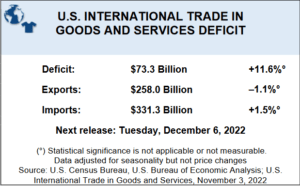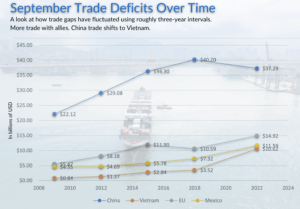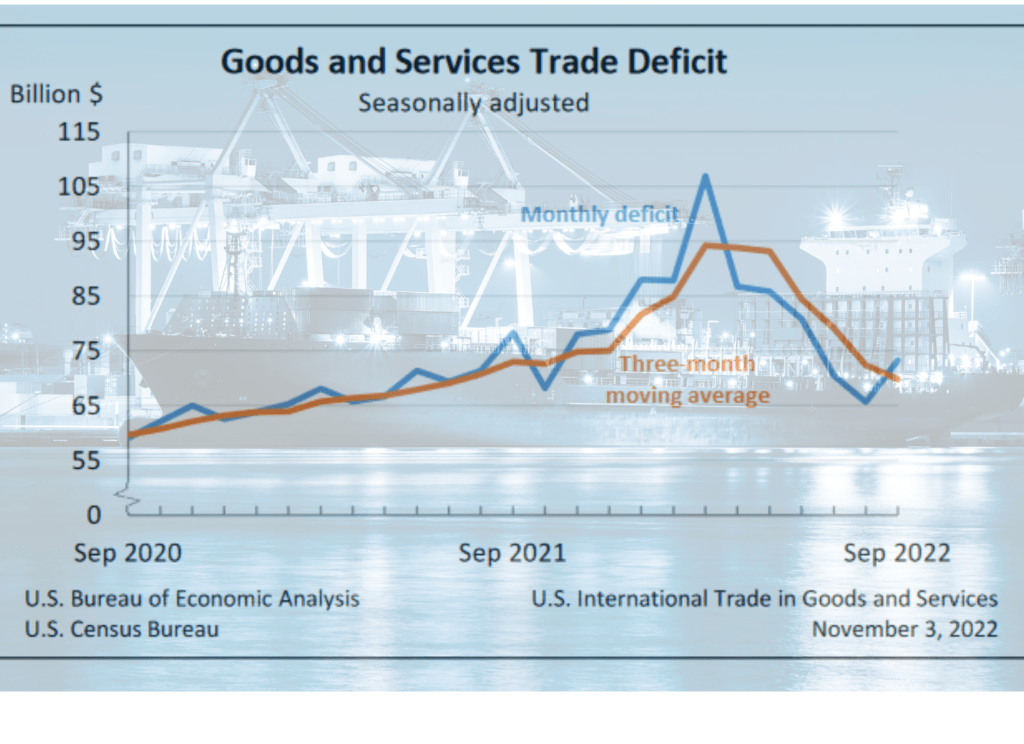After a steady decline in the U.S. goods and trade deficit since April, the deficit bounced back with imports rising 1.5% and exports falling 1.1%. The overall 11.6% rise in the deficit came out to $73.3 billion for the month of September, the Bureau of Economic Analysis said on Thursday.
Year-to-date, the goods and services deficit increased $125.6 billion, or 20%, from the same period in 2021. Exports increased $378.1 billion and imports increased by $503.6 billion, both rising by a little more than 20%. That puts the overall deficit at $745.6 billion for the year.
*** See CPA’s Trade Database for monthly and year-over-year comparisons. * * *
For the trade in goods, however, the deficit for the year ending in September is now a record breaking $922.1 billion. As predicted here, the goods deficit will top $1.1 trillion in 2022 despite inflation not seen since the 1970s, tariffs on China imports, higher capital costs and a general economic slowdown. If companies believe interest rates will remain high next year, we could be in for some front running of imports over the next three months, pushing the goods deficit closer to $1.2 trillion.
The stronger dollar is also a driver of imports as it makes it cheaper to import than to purchase similar goods at home. A strong dollar is a headwind to any U.S. reshoring efforts post-pandemic.
“With 9 months of the year now accounted for in our trade data, we are heading for the world’s first trillion-dollar trade deficit, while China is heading for the world’s first trillion-dollar trade surplus,” said CPA chief economist Jeff Ferry. “While the Chinese domestic economy is failing to deliver what Xi Jinping would like, U.S. consumers, supported by our misguided trade policies, are doing the job for him.”
 Imports of goods increased $2.9 billion to $272.9 billion in September, led by capital goods imports. Interestingly enough, despite semiconductors and telecommunications equipment being lead items in the capital goods cohort, the trade deficit with Taiwan, Japan and China all declined from the previous month. South Korea imports rose but were similar to previous months.
Imports of goods increased $2.9 billion to $272.9 billion in September, led by capital goods imports. Interestingly enough, despite semiconductors and telecommunications equipment being lead items in the capital goods cohort, the trade deficit with Taiwan, Japan and China all declined from the previous month. South Korea imports rose but were similar to previous months.
All told, none of the main trading partners so any big lift-offs in exports to the U.S. Mexico saw the biggest upswing with an $11.9 billion trade gap registered in September, matching its April 2022 numbers.
Even tiny Vietnam, which has become an outpost for Chinese multinationals shipping home goods and solar equipment to the U.S., recorded a lower deficit for the month. Vietnam’s deficit was $10.6 billion, down from a revised $11.4 billion in August.
Trade Figures at a Glance
There are hints in the trade figures that U.S. sourcing from China may have peaked. The deficit with China fell $1.4 billion to $32.1 billion in September. Exports to China fell $0.9 billion to $12.2 billion but imports decreased by $2.3 billion to $44.3 billion. September figures show a general flat-lining from similar months years ago after a peak in 2018.
Still, China companies have moved some manufacturing to Southeast Asia. And if China is not the source, there is little evidence that U.S. companies are bringing supply chains home.

Billion dollar-plus deficits were recorded in September with the European Union ($16 billion), Mexico ($11.9 billion), Vietnam ($10.6 billion), Germany ($7.1 billion), Ireland ($5.5 billion), Canada ($5.3 billion), Japan ($5.2 billion), South Korea ($4.2 billion), Taiwan ($3.8 billion), Italy ($3.6 billion), Malaysia ($3.4 billion), India ($2.5 billion) and Switzerland ($1.9 billion).












